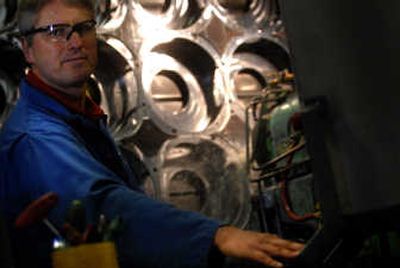‘Help Wanted’ in Washington

Paul May, CEO of Spokane manufacturer Wagstaff Inc., would hire several machinists today – if his company could find qualified candidates.
“Everybody’s very busy and have taken up the available labor force,” May said.
“It’s almost easier to find an engineer than it is to find a machinist.”
May’s concerns echo those of other manufacturers, who are among area firms feeling the crunch of recruiting and retaining qualified workers in a county with only 4.5 percent unemployment, as of August. While economists and business leaders say the labor pinch is a national hurdle facing businesses, construction, health care, and business and professional services companies may be feeling it the most.
“Pretty much across the board, employers in this labor market are having a hard time finding the people they need to fill their positions,” said Mark Mattke, director for the Spokane Area Workforce Development Council.
“Essentially, if you desire to be working, there’s a job available for you at this point in time.”
Wagstaff, which makes equipment for aluminum casting and employs about 260 locally, even teamed with othermanufacturers to place an advertisement for machinists in a national trade publication. That tactic didn’t pay off, May said.
“This is not a local thing,” he said. “It’s a national situation right now, particularly for skilled labor, whether it’s welders, machinists … It’s a big issue, and it’s going to impact us for many years.”
A “really active construction market in the Inland Northwest” was key in driving unemployment rates down, and its success has spilled over into retail, said Grant Forsyth, an associate professor of economics at Eastern Washington University.
“The one concern is we do see some slow-up in other parts of the country,” Forsyth said of the employment rate.
There were about 217,000 nonfarm jobs countywide in August, a 3 percent increase from a year ago, said Jeff Zahir, a regional labor economist for the state Employment Security Department. The county has seen consistent job growth since 2001, he said.
Workers in specialty construction trades, such as finish work or HVAC, may be scarce because laborers are unionized or wages are higher on the West Side of the state, Zahir said. Entry-level jobs in the hotel and other industries may be open because workers are finding better-paying positions elsewhere, he said.
“What I’m sensing in my conversations with employers and in looking at the statistics is that the business community here is not completely uninformed about this,” Zahir said. “A lot of them are stalling on hiring any new people. They are not putting out as many ads. They are holding the staff that they have” and training them.
County unemployment declined through the tech boom of the late 1990s, but peaked in 2002 at 7.6 percent.
The current rate is “not that unique compared to recent history,” said Patrick Jones, executive director of EWU’s Institute for Public Policy and Economic Analysis. “We’re kind of getting back to normal, and I don’t think people realize that.”
“The economy is very robust, specifically the Spokane region,” said Haskins Steel Co. Vice President and General Manager Craig Dias. “I think businesses are looking more favorably upon retention,” so they are redoing benefits and work environments.
It’s unclear whether high employment is driving wage increases locally, Forsyth said, but that’s a possibility when the unemployment rate falls below 5 percent – what some economists consider “full” employment. Construction and manufacturing could see wage pressure, especially for skilled workers, he said.
But while business is booming, the pool of potential workers is declining. The county’s labor force, as a share of its population, has decreased more than 3 percent since 1999. Entry by women has peaked, and teenagers are not participating as much, Jones said.
In the past, migration could have brought more workers to the area, but people are less willing to move with good prospects in their existing areas, said Randy Barcus, chief economist for Avista Corp. And a “housing crunch” is making it even more difficult, he said.
Some workers will switch employers for wage increases, Mattke said, but local officials try to prevent the need for firms to poach employees.
“Most of the job-hoppers have hopped, so your local employer’s kind of maxed out as far as their ability to recruit people from within the community,” said Mike Marzetta, Altek president and chairman of a manufacturers roundtable.
Long-term, manufacturing executives say, high schools and community colleges need to better educate teachers and students about careers that don’t involve liberal arts degrees. Community colleges developed a trades training program that has instructed about 40 students in the past 18 months, said Amy Johnson, a Greater Spokane Incorporated vice president. Greater Spokane produced a career-awareness campaign for middle- and high-school students touting positions in aerospace, manufacturing and health care. And a program this summer gave teachers a firsthand look at those industries.When Avista Utilities faced a shortage of line workers, it started an apprentice program in conjunction with community colleges.
“It’s very encouraging that we do have a low unemployment rate because that means that our community is working, and it also shows the economic growth of our region,” Johnson said.